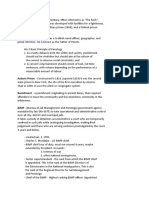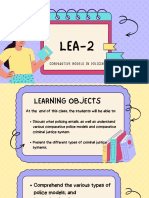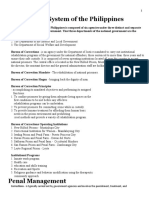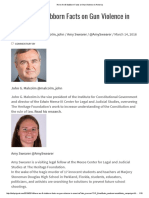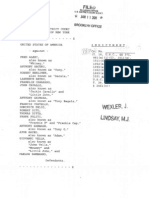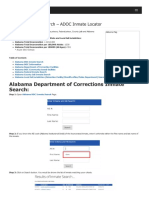College of Criminal Justice: University of Cebu Cebu City
College of Criminal Justice: University of Cebu Cebu City
Uploaded by
Carla Abapo RCrimCopyright:
Available Formats
College of Criminal Justice: University of Cebu Cebu City
College of Criminal Justice: University of Cebu Cebu City
Uploaded by
Carla Abapo RCrimOriginal Title
Copyright
Available Formats
Share this document
Did you find this document useful?
Is this content inappropriate?
Copyright:
Available Formats
College of Criminal Justice: University of Cebu Cebu City
College of Criminal Justice: University of Cebu Cebu City
Uploaded by
Carla Abapo RCrimCopyright:
Available Formats
University of Cebu Cebu City
COLLEGE of CRIMINAL JUSTICE I. II. III. COURSE NUMBER COURSE TITLE
: : CA 1 Institutional Corrections The course covers an examination of the history, philosophy and objectives of imprisonment and the development of prisons. A study of institutional agencies in the Philippines, to include BJMP which overseas city and municipal jails; provincial jails and the Bureau of Corrections and their institutions in terms of their structures, management, standards, programs and services. A critical analysis of the laws creating these agencies to determine areas for possible improvement. CRIM - 2 3 units: 1 Hour lecture/unit
COURSE DESCRIPTION :
IV. V. VI.
COURSE PREREQUISITE : COURSE CREDIT GENERAL OBJECTIVES
: :
At the end of the course, the student should be able to: 1. 2. 3. 4. 5. 6. 7. 8. learn the historical development of penology; discuss the concept of punishment and its purpose; recognize the role of Corrections in the Criminal Justice System; orient themselves with the handling and treating of criminal offenders; know the standard rules in treating prisoners set by the United Nations; explain the classification process through which the rehabilitation, program of prisoners are carried out ; know the legal aspect influencing the Philippine Correctional System; and appreciate the importance of the Code of Discipline regarding the values of honesty, leadership and integrity.
VII.
COURSE OUTLINE: LEARNING TASK/ACTIVITIES CONTENTS
Prelim a. Nature and Trends of Punishment from Pre-Classical School of Penology to the Present - Pre-Classical Theories - Italian or Positive Theories - Modern Clinical School - An Overview of Corrections b. Development of Modern Correctional Concepts and Standards - History of Corrections from the past to present - Early forms of Punishment - The Auburn and Pennsylvania System - The Reformatory Movement - The Classification Movement - The Development of Probation - The Development of Parole Midterm Film Journals Magazines
SPECIFIC OBJECTIVES
At the end of this period, the students are expected to: 1. explain the classical and positive theories of punishment; 2. trace the history of correction from the past to the present; 3. describe the early forms of punishment; 4. differentiate between probation and parole.
TIME ALLOTMENT INSTRUCTIONAL MATERIALS
(3 hrs. per week)
Books/ references Chalkboard and display board
Prayer before and after classes -Lecture (brief, informal, formal) -Discussion of selections
1. Explain the coordination and direction with the Criminal Justice System; 2. Compare between Institutional-
a. The Scope of Correctional Process: -Coordination and Direction with the Criminal Justice System -Coordination of Institution based Corrections
-Lecture (Brief, informal, formal) -Reading selection
(3 hrs. per week)
- Discussion selection
based and Corrections;
Community-based
-Coordination Corrections
of
Community-based -Writing Summaries
3. Differentiate between Bureau of Correction and Bureau of Jail Management and Penology (BJMP
b. The Administrative Organization and Management of Institution Based Corrections: -Bureau of Jail Management and Penology -Bureau of Corrections -Provincial Jails -Lock-up Jails c. The Classification Process -Reception and Diagnostic -The Staff and their Functions -Admission Process -The Staff Conference -The Admission Summary -Transfer out of the Center -The Pre-release Treatment Semi-Final -Lecture (Brief, informal, formal) -Reading selection - Discussion selection
a. The Correctional Treatment Program -Goals of the Treatment Program 1. Explain the goal of the correctional -Employment of prisoners in and out of treatment program; prisons -Services and Activities in and out of 2. Classify the kinds of correctional prisons treatment programs; -Rehabilitation Programs: Its Application and Implementation -Sports and Recreational Activities -Health and Medical Services b. Custody, Security and Discipline -Operation Greyhound and Elimination of
(3 hrs. per week)
-Writing Summaries
Contrabands -Custody, Security, Control and Escorting 3. Identify contraband materials; of Inmates -Inspection of Jails, Security Facilities and 4. Discover the control procedures; Environment -Firearms, Tools, Keys and Weapons 5. Name Security facilities; Control 6. Describe the disciplinary -Discipline and Value Formation Programs and Processes procedures. -Prisoners Right -The Female and the Juvenile Offenders -Institutional Violence and Activities Final -Lecture (Brief, informal, formal) a. The Philippine Prison System -The Build Prison 1. Trace the history of prisons -Bureau of Corrections -The San Ramon Prison and and jails in the Philippines; Rehabilitation 2. Classify the kinds of prisons -The Iwahig Penal Colony -The Davao Penal Colony and jails in the Philippines. -The New Bilibid Prison -The Reception and Diagnostic Center b. Jail Administration -History of Jails -Types of Jails -District, City, Municipal -Lock-ups and Rehabilitation Center for Boys -Reading selection - Discussion selection
(3 hrs. per week)
-Writing Summaries
VIII. EVALUATIVE MATERIALS IX. X. COURSE REQUIREMENTS REFERENCES
: : :
Daily quizzes, Oral recitation, Long exams. Periodic exams Submit analysis or summaries of each chapter 1. Correctional Administration (Institutional corrections) by: Chief Supt. Mercedes A. Foronda 2. Correctional Administration Reviewer by: Wiseman Trading 3. Current Issues/laws clipping in the local and national newspaper
You might also like
- Notes For Comparative Models of PolicingNo ratings yetNotes For Comparative Models of Policing42 pages
- Chapter 6 - Institutional Corrections Part 2No ratings yetChapter 6 - Institutional Corrections Part 217 pages
- Biopsychosocial Theories of Crime Causation100% (1)Biopsychosocial Theories of Crime Causation6 pages
- Amigo Reviewer For Correctional InstitutionNo ratings yetAmigo Reviewer For Correctional Institution12 pages
- Introduction To Forensic Chemistry and Toxicology100% (1)Introduction To Forensic Chemistry and Toxicology3 pages
- Comparative Models in Policing - Module 1 - Preliminary Reviewer100% (1)Comparative Models in Policing - Module 1 - Preliminary Reviewer3 pages
- Dec 2022 Leadership Decision Making Management and AdministrationNo ratings yetDec 2022 Leadership Decision Making Management and Administration28 pages
- 2300 B.C - Sumerians Set Standards On What Constituted An Offense Against Society - The Sumerian CodeNo ratings yet2300 B.C - Sumerians Set Standards On What Constituted An Offense Against Society - The Sumerian Code8 pages
- Additional Notes in Traffic Management and Accident InvestigationNo ratings yetAdditional Notes in Traffic Management and Accident Investigation12 pages
- Bigwas Drug Education and Vice Control ReviewerNo ratings yetBigwas Drug Education and Vice Control Reviewer8 pages
- Juvenile Delinquency and Crime Prevention (Autosaved)100% (1)Juvenile Delinquency and Crime Prevention (Autosaved)183 pages
- Character Formation 2-Leadership, Decision Making, Management and Administration Sumarization of Management, Manager, Mission, Vision and ValuesNo ratings yetCharacter Formation 2-Leadership, Decision Making, Management and Administration Sumarization of Management, Manager, Mission, Vision and Values14 pages
- In The Lahore High Court, Lahore: Crl. Misc. No.9464-B/2021No ratings yetIn The Lahore High Court, Lahore: Crl. Misc. No.9464-B/20213 pages
- Petitioners Vs Vs Respondent: Second DivisionNo ratings yetPetitioners Vs Vs Respondent: Second Division8 pages
- Here Are 8 Stubborn Facts On Gun Violence in AmericaNo ratings yetHere Are 8 Stubborn Facts On Gun Violence in America10 pages
- Penology and Victimology: SUBMITTED TO-Dr. Ruchi Sapehia Submitted by - Vaibhav Katoch B.B.A. LL.B. (9 SEM.) 1120171829100% (1)Penology and Victimology: SUBMITTED TO-Dr. Ruchi Sapehia Submitted by - Vaibhav Katoch B.B.A. LL.B. (9 SEM.) 112017182914 pages
- Psychological Association of The Philippines "On Reinstituting The Death Penalty" (2017-01)No ratings yetPsychological Association of The Philippines "On Reinstituting The Death Penalty" (2017-01)3 pages
- A Study of Juvenile Prisoners in Borstal Jail BahawalpurNo ratings yetA Study of Juvenile Prisoners in Borstal Jail Bahawalpur14 pages
- ANSWER KEY - ASSIGNMENT - Criminal Law 1No ratings yetANSWER KEY - ASSIGNMENT - Criminal Law 110 pages
- Alabama Inmate Search Department of Corrections LookupNo ratings yetAlabama Inmate Search Department of Corrections Lookup7 pages
- The-Impact-of-Reserve-Officer-Training-Corps (2)No ratings yetThe-Impact-of-Reserve-Officer-Training-Corps (2)15 pages
- Comparative Models in Policing - Module 1 - Preliminary ReviewerComparative Models in Policing - Module 1 - Preliminary Reviewer
- Dec 2022 Leadership Decision Making Management and AdministrationDec 2022 Leadership Decision Making Management and Administration
- 2300 B.C - Sumerians Set Standards On What Constituted An Offense Against Society - The Sumerian Code2300 B.C - Sumerians Set Standards On What Constituted An Offense Against Society - The Sumerian Code
- Additional Notes in Traffic Management and Accident InvestigationAdditional Notes in Traffic Management and Accident Investigation
- Juvenile Delinquency and Crime Prevention (Autosaved)Juvenile Delinquency and Crime Prevention (Autosaved)
- Character Formation 2-Leadership, Decision Making, Management and Administration Sumarization of Management, Manager, Mission, Vision and ValuesCharacter Formation 2-Leadership, Decision Making, Management and Administration Sumarization of Management, Manager, Mission, Vision and Values
- In The Lahore High Court, Lahore: Crl. Misc. No.9464-B/2021In The Lahore High Court, Lahore: Crl. Misc. No.9464-B/2021
- Here Are 8 Stubborn Facts On Gun Violence in AmericaHere Are 8 Stubborn Facts On Gun Violence in America
- Penology and Victimology: SUBMITTED TO-Dr. Ruchi Sapehia Submitted by - Vaibhav Katoch B.B.A. LL.B. (9 SEM.) 1120171829Penology and Victimology: SUBMITTED TO-Dr. Ruchi Sapehia Submitted by - Vaibhav Katoch B.B.A. LL.B. (9 SEM.) 1120171829
- Psychological Association of The Philippines "On Reinstituting The Death Penalty" (2017-01)Psychological Association of The Philippines "On Reinstituting The Death Penalty" (2017-01)
- A Study of Juvenile Prisoners in Borstal Jail BahawalpurA Study of Juvenile Prisoners in Borstal Jail Bahawalpur
- Alabama Inmate Search Department of Corrections LookupAlabama Inmate Search Department of Corrections Lookup





